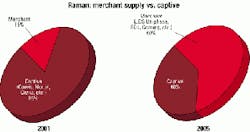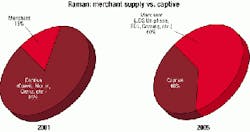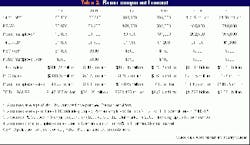Raman amplification: longer, wider, faster, cheaper
Growing traffic demands and the quest for cost savings point to an increase in demand for Raman amplification.
RICK SCHAFER and JIM JUNGJOHANN, CIBC World Markets
Since 1996, network-traffic growth has continued at a torrid pace, with Internet traffic doubling every 100 days and overall network traffic growth approaching 100% annually. However, operators using Dykstra's algorithm and spanning trees are expanding network capacity at six to nine times the pace of traffic growth, because with the bursty nature of data traffic, they in some cases have difficulty forecasting bandwidth demands much further than six months.
To meet current and future demand, service providers are embracing bandwidth-expanding, next-generation optical technologies across all enabling bands, including ultra-long-haul WDM systems provided by Corvis, Ciena, Nortel Networks (Qtera), and Sycamore Networks. Three key industry trends pushing the market forward are the movement to higher-channel-count WDM (80-plus channels); higher transmission speeds (10 and 40 Gbits/sec); and longer distances between regeneration (i.e., costly optical-electrical-optical, or OEO, conversion) points.Optical amplification, specifically next-generation Raman amplification, is fundamental to supporting these trends, as leading next-generation carriers like Broadwing, Williams, and Level 3 race to design lowest-cost-per-bit networks.
Raman amplifiers can be broken down into two fundamental categories: distributed and discrete. The term "distributed" is used to describe Raman amplification that relies on the transmission fiber itself to achieve gain. This group can be further subdivided into cascaded and diode-based Raman.
Cascaded Raman using fiber pump lasers is typically used for undersea and remote amplification, given its relatively high launch powers. Diode-based distributed Raman uses high-powered 14xx-nm pump lasers to achieve launch powers typically in the 500-mW to 1-W range. We believe diode-based distributed Raman will come to dominate the terrestrial market as ultra-long-haul, high-channel-count, high-speed system deployments explode in 2001.Distributed Raman amplification reduces the gain required of an erbium-doped fiber amplifier (EDFA), while providing a dramatic improvement in the overall noise figure (NF). That translates to a six-fold or more improvement in the distance traveled between OEO regeneration sites. For this reason, we believe Raman will play a crucial role in high-speed optical networks above the current 10 Gbits/sec (OC-192) to 40 Gbits/sec (OC-768).
We expect that diode-pumped Raman will, for the most part, complement the existing EDFA market, with a majority of systems positioning a Raman box ahead of each EDFA box as a "preamp." That is necessary because average amplifier spacings (span lengths) in operators' networks are currently above 75 km. However, some cannibalization of EDFA business likely will occur in the near term, as WDM systems providers like Corvis are able to achieve high (20-dB) launch powers from their Raman amplifiers, as operators like Broadwing and Williams light networks with reduced 40-50-km hut spacings. At the powers Corvis is achieving, it is possible (and desirable) to eliminate EDFAs altogether under ideal conditions-i.e., short span lengths (<50 km) and lower transmission speeds (10 Gbits/sec or less). Longer term, however, many of these tighter-spaced networks will likely deploy EDFAs and Raman amplifiers in tandem, as 40-Gbit/sec gear takes hold in 2002.We expect diode-based distributed Raman could jump from about $220 million in 2000 to roughly $4.5 billion in 2005. Cascaded Raman solutions should grow from $25 million to $243 million over the same period, as undersea WDM system deployments proliferate.
Discrete Raman is simply a stand-alone amplifier, similar to an EDFA in that the signal is not amplified in the transmission fiber but piped into a discrete box where it travels through a length of specialty fiber (typically small-effective-area fiber) where gain is achieved. This technology, yet to catch on commercially, is somewhat limited in its potential application. System designers will most likely deploy discrete Raman to overcome localized loss. An example of localized loss could include a switch, optical add/drop multiplexer (OADM), or simply a splice of dispersion-compensating fiber.
Although discrete Raman does not offer the reduced NF benefits of distributed Raman, it does share the flexible gain profile of its distributed cousin. Little more than a science project at this stage, we expect discrete Raman sales could find a home in metropolitan and long-haul WDM networks-albeit with a much smaller footprint than distributed Raman. We expect the market for discrete Raman could ramp from less than $1 million this year to $60 million in 2005.
Although still a relatively nascent industry group, we expect the usual optical OEMs will come to dominate the market for Raman amplifiers. Notably, Nortel (Qtera), Corvis, Ciena, JDS Uniphase, SDL, Corning, Furukawa, Lucent Technologies, and Alcatel all appear well positioned to garner a share of the Raman market we forecast at $4.8 billion by 2005 from $245 million in 2000. We believe captive suppliers currently dominate the market, but expect that over time, merchant suppliers will become an increasingly integral part of the supply chain-much like what has happened in the EDFA market (see Figure on page 80).
Early in the 1990s, scientists began experimenting with solitons (a form of light) for optical transmission. Raman, widely considered the best means of amplifying solitons, seemed poised to take off. Then came the EDFA, which subsequently fostered widespread deployment of WDM. EDFAs had a distinct advantage over Raman in the amplification of light signals in the erbium band (1,530-1,565 nm), both in terms of efficiency (Raman amplifiers' power -conversion efficiency was approximately 25%, compared with approximately 80% for EDFAs), but even more importantly in the ready availability of key components (reliable, high-powered 980-nm pumps, etc).
Notably, high-powered 14xx-nm pumps-the engines of diode-based Raman-were in extremely short supply, a situation that only recently has begun to improve.
Indium phosphide (InP)-based 1,480-nm and 14xx-nm pumps met with early acceptance (for erbium-based and Raman amplification, respectively), because they offered a high degree of reliability relative to early-generation gallium arsenide (GaAs)-based 980-nm pumps. However, the introduction of patented 980-nm mirror passivation processes at JDS Uniphase and SDL led to vastly improved 980-nm reliability, with both companies producing these pumps with failure-in-time (FIT) scores near 50, equating to a meantime to failure of more than 100 years. Because 980-nm pumps were inherently more powerful (and introduced less noise when used in the first stage of EDFAs), Raman and 14xx-nm pumps were pushed to the back burner.
Raman amplification appears ready to blossom as supply of 14xx-nm pumps has improved greatly over the past 12 months, led by ramping production at leading manufacturer Furukawa as well as Alcatel, Sumitomo, and JDS. Several pump lasers may reside inside one Raman amplifier. The reasons designers architect multiple pumps into their diode Raman boxes are several-fold. First, high-powered 14xx pumps are still relatively difficult to find in volume (and very expensive, once a supply can be secured). The second issue is reliability-the more pumps an amplifier has, the better it will be protected from the failure of any single laser. Remember that when an amplifier fails, the related WDM span typically dies with it. Third, the unique properties of InP-based 14xx-nm pumps allow system architects to design Raman amplifiers with pump lasers of varying wavelength, enabling a very flat-gain shape without the use of power-robbing gain-flattening filters.
Although the actual number of 14xx pumps per diode-based distributed Raman amplifier can be as high as eight, for the purposes of our forecast, we are assuming an average of six. Amplifiers begin to get too complex beyond eight pumps. Also, we expect higher-powered pumps will become more readily available in the future, keeping the average number of pumps per Raman amplifier at around five or six. Assuming an average of six high-powered 14xx-nm pump modules per diode-based Raman box, we anticipate the 14xx-nm market could jump from $108 million this year to $2.3 billion in 2005.
Polarization beam combiners (PBCs)-a passive optical component that can be all fiber- or bulk-optic-based-are another key component of diode-pumped Raman amplifiers. To boost amplifier power, manufacturers must increase the effective power supplied by the pump lasers. To accomplish that, a designer can buy high-powered pump lasers like those supplied by Furukawa, Alcatel, JDS, etc.; however, these products remain in tight supply. As an alternative, designers can use PBCs to combine the output of two relatively lower-powered pumps-operating at the same wavelength but in different polarization modes-into a single fiber, thereby doubling the effective power output. PBCs also can be used in EDFAs, typically to combine 1,480-nm pumps in the second stage.
Based on an initial assumption of an average of three PBCs per diode Raman amplifier (falling off to two in the out years, as average pump's power continues to increase), we anticipate the market for PBCs in Raman could approach $30 million in 2000, ramping to $497 million in 2005. Leading suppliers of PBCs include JDS, Furukawa, and New Focus for bulk-optic designs, and JDS, ITF, and Wavesplitter for all-fiber devices. All-fiber devices appear to be gaining ground on bulk-optic designs because they are better able to handle very high powers while offering extremely low insertion loss.
Another important component, the pump multiplexer, is often used in tandem with PBCs to combine the different wavelengths of 14xx-nm pump-laser modules used in Raman amplifiers. As with PBCs, pump multiplexers are available either as bulk-optic or all-fiber devices. Also, as with PBCs, it is critical that bulk-optic packaging techniques use no epoxy in the optical path, allowing the product to be used in high-power, high-channel-count WDM systems.
The pump multiplexer (also called a "pump combiner") boasts a very flat, wide passband, low insertion loss, and high isolation. The same market drivers pushing PBC growth apply to pump combiners.
The exception is that we assume each diode-based Raman box sold will contain one pump multiplexer, compared with two or more PBCs.
Market-research firm RHK estimates the total market worldwide for mux/demux filters will grow to $3.5 billion in 2004. We estimate the market for WDMs used in Raman combining pumps (less than 5% of total market) will be roughly $9 million this year, ramping to $230 million in 2005. Key competitors in this space include JDS, Oplink, and Corning, and privately held competitors ITF, Dicon, and Wavesplitter.
Long-haul terrestrial networks may not be the only emerging markets for Raman amplification. Another market, to date largely untapped, is metropolitan WDM networks. Estimates of metro's potential size vary from a fraction of two or more times the long-haul opportunity.
The high cost of WDM technology versus other alternatives (among other things, simply deploying more fiber) has hampered its acceptance in metro applications. That has put pressure on systems OEMs to introduce price-competitive products for the local loop. Component suppliers in turn have felt compelled to develop lower-cost technologies.
To this end, we expect that new, low-cost optical amplifiers, known as "amplets," could begin gaining traction in 2001 with an initial price tag of around $5,000. Notably, we believe several different amplifier designs/technologies could fall under the amplet umbrella. In addition to scaled-down EDFA designs and semiconductor optical amplifiers (SOAs), Raman amplifiers could play a meaningful role. We expect discrete Raman could find a market in the metro environment as an efficient method of adjusting for localized loss (at switches, OADMs, etc.).
Underpinning such statements is our belief that despite reports to the contrary, optical amplification will play a large role in metro architectures. The metro market inherently requires all sorts of routing, multiplexing, and switching-all of which operators must pay for in localized signal loss. This handling-associated loss is comparable to the absorption loss experienced in long haul. Amplets-probably single-pumped EDFAs, SOAs, and discrete Raman amplifiers-would sit on the outputs of switches and OADMs to rebalance powers.
Pumping power for these amplets would be provided by low-cost, low-power 980-nm and 14xx-nm pump lasers. These lasers would not compete with the cutting-edge pumps, with their incredibly tight tolerances, but would instead play in a market with looser specifications, where capacity is not much of a concern. These pump modules most likely would sell for less than $500, compared with the $2,200 price tag for higher-powered modules.
Note that with leaders JDS Uniphase and SDL both basically doubling chip capacity over the next 12 months, overall capacity in 980-nm pumps could soon be much less of an issue. In addition, this lower-end market will be more inviting to competition, with Spectracom (ADC), Corning, Furukawa, and others likely to find a larger market for their products. Given its scaled-back design and lower specifications, we believe the amplet could soon sell for less than $2,000 as volumes ramp.
In addition to the metro space, the submarine market opportunity for WDM is huge and growing fast. In fact, we expect the undersea WDM market could rival that of the terrestrial market, despite its relatively lower number of fiber-miles deployed. That's because the extreme reliability demanded of optical systems and components for undersea use means costs can run three times or more that of a typical terrestrial WDM system.
Cascaded Raman, which boasts very high launch powers of 1 W and more, are well suited to certain undersea applications, specifically remote pumping and amplification. In a festooned WDM architecture, a fiber-optic cable is dropped just off the coast of a continent or island. Every 400 to 600 km, the cable is looped back to the shore into huts containing network elements like OADMs and amplifiers. The benefit of this design is that no active components are located underwater. That helps improve system costs and the reliability of the network. The cascaded Raman amplifier sits in the hut and uses the transmission fiber itself to amplify the oncoming signal (hence, cascaded Raman meets the definition of a distributed Raman device).
Tables 1 and 2 provide a further breakout of our forecast for the Raman and Raman component markets. To derive our estimates, we spent a considerable amount of time contacting numerous carriers, original equipment manufacturers, and component manufacturers. Like the forecasts we published in our Aug. 5, 1999 report, "Pumped Up on the Optical Amplifier Market," we believe this forecast to be neither too aggressive nor overly conservative.
Notably, RHK predicts the domestic terrestrial market for Raman will be $1 billion in 2004. We have decided to include in our forecast worldwide demand, both terrestrially and undersea (the latter a market that could ultimately rival the terrestrial in size and scope). Additionally, unlike our August 1999 forecasts for the relatively established EDFA and 980-nm pump markets, the market for Raman and its related components is only just beginning to take off. We therefore assume more aggressive Raman unit numbers for 2000, as OEMs build initial inventories.
Several of the industry experts we consulted felt strongly that our numbers should be much more aggressive than those published herein; however, we feel confident based on current trends and visibility that our numbers represent a fair and realistic view of total market potential.
Rick Schafer and Jim Jungjohann are research analysts for CIBC World Markets (Denver), focusing on the optical-networking and components industries.
Stimulated Raman scattering occurs when lightwaves interact with vibrations of atoms in a crystalline lattice (optical fiber, in the case of fiber-optic telecommunications). The atom absorbs the light, then quickly re-emits a photon with energy equal to the original photon plus/minus atomic vibration. Raman scattering goes both forward and backward on a fiber and can cause crosstalk.
Raman scattering, as defined above, can create headaches for systems designers as a source of fiber nonlinearities, because it can steal energy away from one wavelength and transfer it to another. Interestingly, this effect can be put to use as a means to amplify weak optical signals.
Raman amplification occurs when higher-energy (shorter-wavelength) pump photons scatter off the vibrational modes in optical fiber, thereby coherently "stimulating" or adding energy to lower-energy (longer-wavelength) signal photons. In English, this means Raman offers a double benefit. First, it helps move bandwidth-robbing, nonlinear effects (four-wave mixing, cross-phase modulation, self-phase modulation, etc.) out of the signal band and into the amplifier band, resulting in a cleaner signal. Second, the removed nonlinear effects are actually put to work amplifying the signal.
Advantages of Raman include the ability to amplify over a broad spectral range (flexible gain profile), i.e., in more than just the standard 1,550-nm long-haul transmission window. Raman can amplify in the 1,310-nm range, making it potentially attractive for short-haul amplification, where 1,310-nm transmission is common. To accomplish 1,550-nm amplification, designers typically use pump lasers transmitting in the 1,450-nm band, while 1,310-nm amplification requires a 1,240-nm pump source. A general rule of thumb when considering Raman amplification is that the combined pump wavelength should be about 100 nm shorter than the signal being amplified.
A drawback to Raman is the high powers necessary to make it work. Normally, Raman requires output (launch) power in the 1-W range, although some newer systems get adequate gain from 500-750 mW of output.



